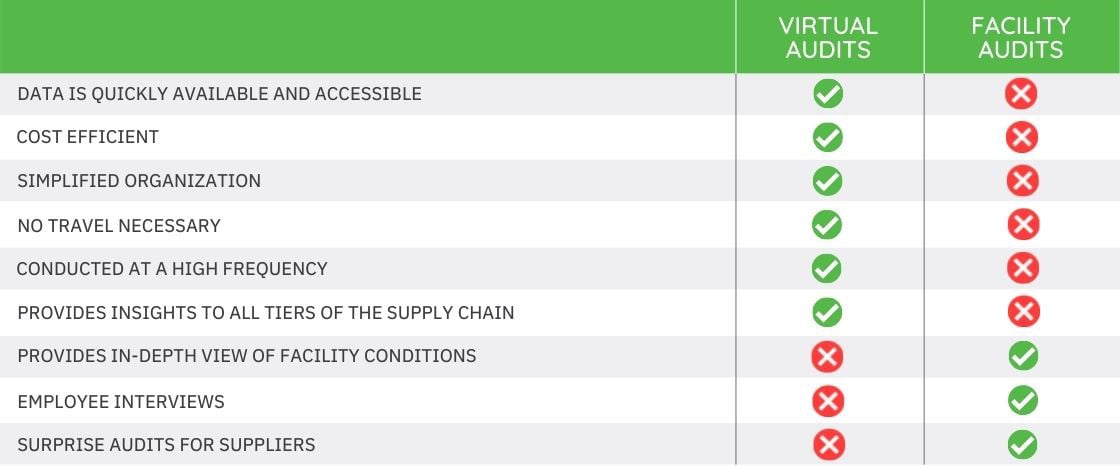Supply Chain Audits: Virtual Audits VS. Facility Audits
A core responsibility of supply chain executives is to ensure the brand can deliver products measuring up to customers’ expectations of quality. Another essential duty is assuring compliance with various regulatory programs ranging from materials sourcing to chemical composition and human rights. There is also an obligation to have systems in place that will help satisfy stakeholders’ expectations, especially in terms of environmental and social responsibility.
One of the most effective ways to address transparency and sustainability is to conduct supply chain audits. Traditionally, organizations sent auditors to the field to visit suppliers’ facilities. Digitalization started to introduce the concept of virtual audits. The Covid pandemic recently contributed to the fast adoption of this method, due to travel restrictions and health concerns.
As much as this crisis crippled supply chains, it also had the advantage of highlighting the risks and damages associated with a value chain that lacks resilience. This provided all the more reason for supply chain leaders to implement auditing processes remotely or in person.
In this article, we’re looking at the comparative merits and limitations of virtual audits and facility audits, as well as explaining why they are not mutually exclusive.

Supply Chain Virtual Audits
As previously mentioned, virtual audits have gained in popularity due to the pandemic. They are nothing new, however. Many businesses have realized the benefits of completing the auditing process from the comfort of their desk for some time.
In essence, an e-audit, as it’s sometimes called, follows the same principles as an on-site assessment visit. The objective is to check the supplier’s status on key issues, including:
- Regulatory compliance
- Corporate policies or code of conduct
- Workers’ welfare and safety
- Suppliers’ standard practices
- Environmental concerns
- Areas of supply chain risks
- Quality Management
Using technology to assess a supplier’s performance or to vet a potential partner before onboarding presents a multitude of benefits.
Virtual Audits Advantages
Data is quickly available and accessible from any corner of the globe, reducing time wasted traveling to go collect it and manually verify it.
Significant savings are made by eliminating airfare, lodging, and other logistic constraints.
Organization is greatly simplified. Virtual supply chain audits eliminate the need to synchronize people’s availability, coordinate accommodations, etc.
There’s no need to worry about travel accessibility. Supply chains can spread widely, and some suppliers may be located in difficult to access areas, or in places where the administrative process to enter is complex. That can be the case for countries with a restrictive government, countries that have strict vaccination rules for visitors (such as some African states), or sites that are simply too remote and isolated to reach without deploying considerable efforts. Virtual audits can greatly assist during times of social distancing.
Audit teams gain in efficiency and productivity as tasks are completed more quickly and in a more comfortable environment.
Audits are more standardized, using technology to trigger questions based on specific answers, whereas facility audits usually consist of a predetermined checklist that doesn’t offer much flexibility.
Businesses can conduct virtual audits at a higher frequency and at a larger scale than onsite audits. Because of the significant cost and resource savings, businesses can conduct as many virtual audits per year as they see fit, as opposed to only having the budget or resources for one onsite audit per year.
Although attractive at many levels, remote supply chain audits are not always the best option and are not always applicable in some cases.
Virtual Audits Limitations
Audits aiming to assess manufacturing processes or product storage are difficult to conduct remotely. Even with the use of live video, visual inspection is best performed on-site.
Despite some degree of flexibility since the pandemic has limited the possibility to travel, some certification bodies still have not approved virtual auditing. In March 2020, ISO and IAF published guidance on remote audits. While it states that virtual audits are acceptable in some instances, they recommend using discretion.
Suppliers familiar with the auditing process may use their knowledge to hide issues that would be detected by walking the grounds.
Communication is altered and cues revealed by body language are not as strong in non-verbal audits, which makes it harder to reveal potential risks and inconsistencies.
Information and communication technologies have greatly improved auditing efficiency, but nothing is ever perfect. Both auditors and auditees need reliable equipment and connections which may not be the case in isolated, rural, or underprivileged areas.
One area where extreme prudence should be used is cybersecurity. If suppliers have not invested in secure systems, data transfer can be compromised and connections may be hacked, leaving a back door open for data theft or malware. Let’s keep in mind cybercriminals are in a very profitable business, raking in around $1.5 trillion a year according to Tech Republic.
The secret to successful audits rests in preparation and a clear definition of the objectives. There is a balance to be found between e-audits and facility audits.
Onsite Supplier Audits
Onsite audits are a more traditional method to assess a supplier’s profile against key compliance issues. Their advantages are complementary to virtual audits’ limitations.
Assessing workplace conditions is more effective when touring facilities. Physical inspection can reveal the state of the equipment and suspect odors that hint at a lack of cleanliness or a leak of hazardous chemicals. Seeing workers in action is also a good source of information: their behavior, general physical state, posture, or reluctance to make eye contact can give clues as to how they are treated.
Auditors have the opportunity to stray from the script and interview employees. Suppliers who deny the request to obtain a few minutes to talk with workers may be at higher risks of concealing human rights violations.
They also are given the possibility to randomly inspect products and check for quality.
Physical supply chain audits provide the opportunity to tour the grounds and gauge potential environmental risks. Are there signs of improper waste management of dangerous substances? Is the water quality questionable? Has the land been stripped of all trees and greenery?
Negative Effects Of Facility Audits
Facility auditing takes time for both auditors and auditees. Dealing with auditors all year long is a hefty disruption. Some companies share auditors to minimize the inconvenience, but this practice can raise doubts in terms of information accuracy and possible conflicts of interest.
Announced audits could incite suppliers to falsify records, remove evidence of wrongdoing, and “spruce up” the place to make a good impression. Exploited workers could be replaced with people who support the practices.
Facility audits typically provide insight on Tier 1. The depth of modern supply chains makes it nearly impossible to conduct assessments on all tiers of suppliers. Organizations mostly focus on Tier 1, but oftentimes a company’s entire supply chain is 10x the size of Tier 1 alone. It is often further down the supply chain that violations are committed, namely forced and child labor.
Balancing Supply Chain Auditing Methods
Virtual audits and facility audits are both robust methods to help keep the value chain transparent and sustainable. An approach that combines the two is a great opportunity to better manage and mitigate risks. Based on virtual audit data collected, supply chain executives gain a clear view of high-risk areas across all tiers of their value chain and may opt to perform on-the-ground audits for suppliers presenting the most suspect characteristics.
Supply chain quality inspection and audit processes need not be over-costly nor cumbersome. A robust risk management strategy vastly depends on the accuracy of the information received and analyzed.
Source Intelligence’s Facility Audit and Virtual Audit Solutions focus on supplier engagement and a strong platform to effectively transform data into actionable insights.
- Customized CSR Reporting
- Centralized Data Storage
- Supplier Performance Rating
- Automated Supplier Engagement Processes
Are you ready to simplify the auditing process, improve efficiency and productivity, and reduce overhead costs? Request a demo of our supplier auditing programs today.



